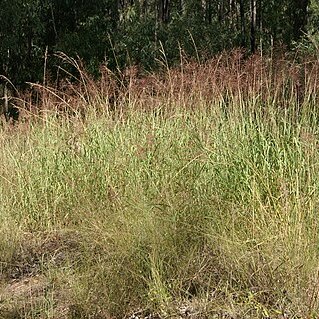Culms 100–150 cm high, simple or rarely branched, glabrous or appressed-hairy, aromatic; nodes glabrous, pubescent or bearded. Leaves: ligule a short, truncate membrane, ciliolate, to c. 1 mm long; blade to 40 cm long, 5–8 mm wide, predominantly glabrous with short scabrid hairs along margins and veins and long turbecle base hairs towards base of blade. Inflorescences 11–25 cm long, 5–7 cm wide, often purple-tinged; peduncles (shared stalk of final branch/raceme) 3–10 (–15) cm long; final branch with 3–8 spikelet clusters. Terminal spikelet clusters with 3 hetermorphic spikelets (1 sessile spikelet and 2 pedicellate spikelets), lower clusters with only 2 heteromorphic spikelets (1 sessile spikelet and 1 pedicellate spikelet); each cluster with short hairs on callus of sessile spikelet and pedicels and internode. Sessile spikelets broadly linear, narrowly elliptic, oblong-lanceolate or lanceolate, 2.2–4.2 mm long; lower glume shape as per spikelet, narrowly truncate, slightly depressed on back or flat, scabrous all over, ciliate on keels, 8-or 9-veined (4 or 5 intracarinal veins sometimes obscure and difficult to see); upper glume lanceolate, similar in length to lower glume, scaberulous upwards on thickened or distinct midvein or keel, or nearly smooth, tapered to acute point at apex, raised veins distinct either side of midrib forming marginal keels; lower lemma ovate, 2–2.8 mm long, sterile; upper lemma stipitiform and tapering into an awn, 12–18 mm long; bisexual, anthers c. 1.2–1.6 mm long. Pedicellate spikelets subulate or ± lanceolate, 2.8–4.3 mm long, acute; lower glume 5–7-veined, ± scaberulous, ciliate on keels; upper glume 1–3-veined (sometimes much shorter than lower glume or absent); lower floret with lemma as long as glumes, very short, or absent, male or sterile; upper floret not seen. Caryopsis 1.7–2.8 mm long.
More
Perennial. Culms tufted, up to 150 cm tall, unbranched, nodes bearded. Leaf sheaths usually pilose, ciliate at mouth; leaf blades 15–40 × 0.5–0.8 cm, scaberulous or pubescent, usually hispid with tubercle-based hairs toward base, base rounded, apex acuminate; ligule 0.5–1 mm. Panicle oblong-ovate in outline, 10–18 × 5–8 cm; branches untidily flexuous, pilose in axils; racemes composed of 3–7 spikelet pairs below the terminal triad, purple; rachis internodes and pedicels ciliate. Sessile spikelet 3–4 mm; lower glume oblong-lanceolate, slightly glossy, back 4–5-veined, scarcely depressed along midline, sparsely hispidulous, margins keeled, pectinate-ciliate above middle, apex narrowly obtuse; upper glume ciliate along upper margins; awn of upper lemma 1.2–1.8 cm. Pedicelled spikelet equaling the sessile and often staminate, or smaller and barren. Fl. and fr. autumn. 2n = 40.

